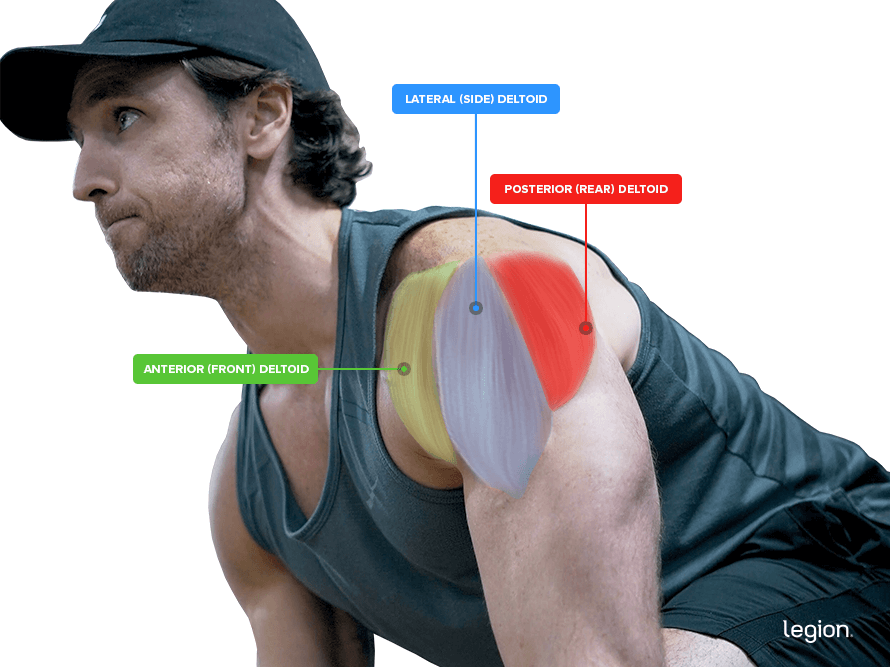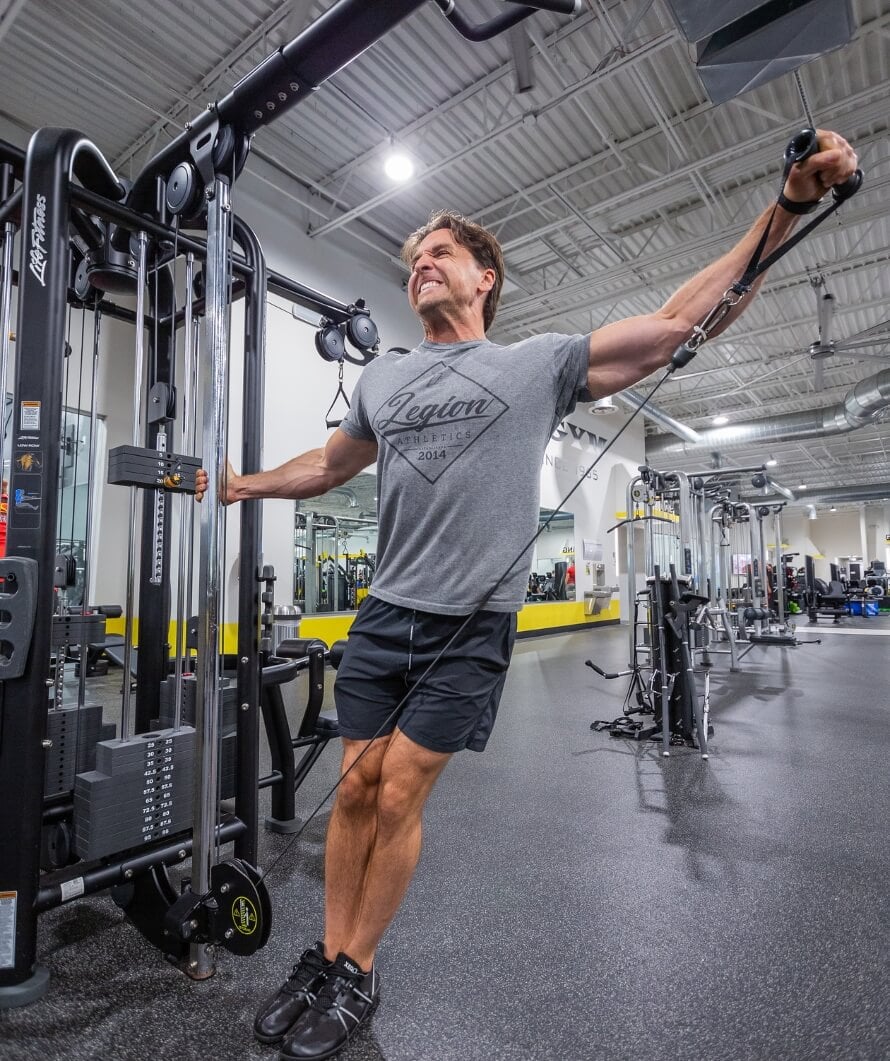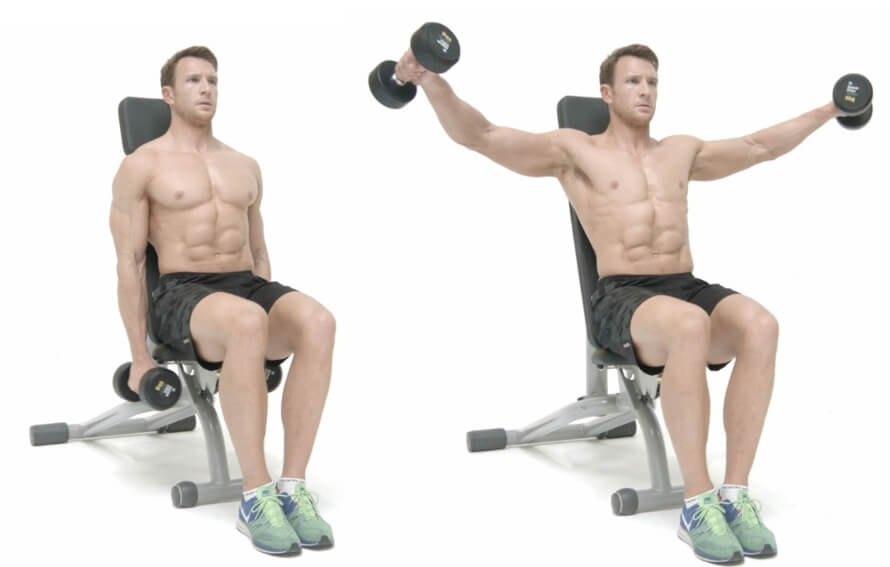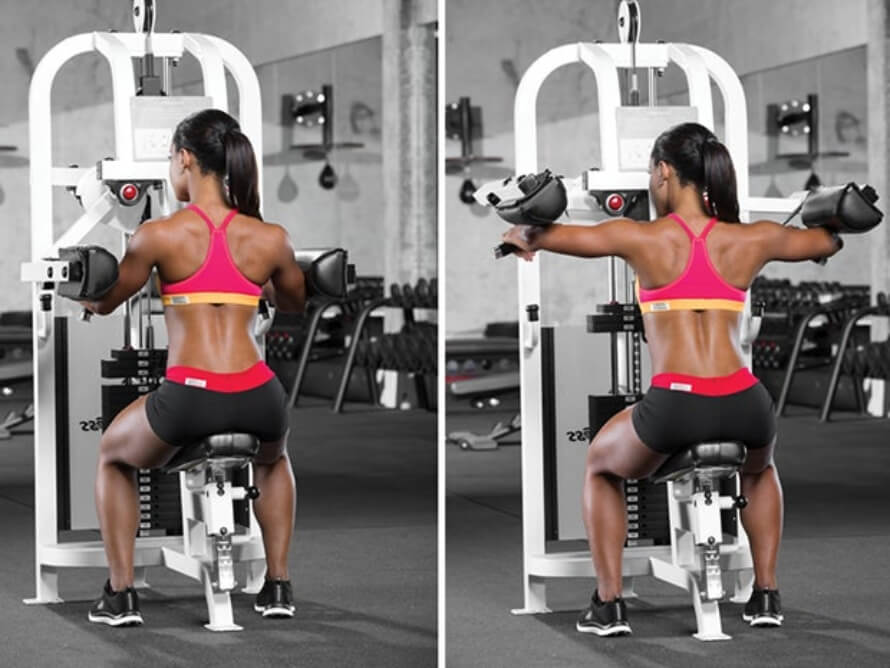Lateral raises—also known as dumbbell lateral raises, DB lateral raises, side lateral raises, and lateral arm raises—are a staple exercise for building strong, powerful shoulders.
Although lateral dumbbell raises look like a cakewalk—you hold a dumbbell in each hand and lift your arms—there’s much wrangling among fitness experts about the right way to do them.
Some say you should do side raises for high reps with light weights; others say you should go heavy.
Some say you should do them with your elbows perfectly straight; others say your elbows should be slightly bent.
Some say you should keep your torso perfectly still; others say a little body English is acceptable.
Who’s right?
What constitutes proper lateral raise form?
We’re going to unravel the answers to those questions in this article. By the end, you’ll understand exactly how to do lateral raises to build well-rounded, defined shoulders, and how to steer clear of the most common form mistakes.
Lateral Raises: Muscles Worked
The main muscles worked by lateral raises are the deltoids—the shoulder muscles that help you move your upper arms forward, upward, and backward.
The deltoids are made up of three sections or “heads:” the anterior deltoid (or “front delt”), the lateral deltoid (or “side delt”), and the posterior deltoid (or “rear delt”).
Here’s how these muscles look on your body:

Although side lateral raises train all three heads of the deltoids, they’re particularly effective at targeting the lateral head (hence the name).
You’ve probably also heard that your delts are trained by compound exercises like the bench press, overhead press, and barbell row, so you may be wondering if isolation exercises for your shoulders like lateral raises are worth doing.
While you don’t need to do lateral raises and other isolation exercises for your shoulders—you can make plenty of headway with compound exercises alone—there are two reasons I recommend them and include them in my programs for men and women:
- Well-developed side delts make your shoulders appear broader, which balances your upper-body aesthetics and is generally considered to be more physically attractive in men. They’re also helpful for women, as side raises make your shoulders look more defined (and don’t worry, it’s basically impossible to make your shoulders look “too big” as a woman unless you’re taking steroids).
- The side delts are stubborn muscles that aren’t trained well by many compound exercises, and they can lag in development if you don’t use isolation exercises to train them specifically.
As well as training the deltoids, side lateral raises also train the upper traps, but this isn’t the focus of the exercise.
How to Do Lateral Raises
The secret to nailing lateral raise form is to break the exercise up into three phases: prepare, raise, descend.
Step #1: Prepare
Stand up straight with your arms at your sides and a dumbbell in each hand with your palms facing each other. Position your feet just inside shoulder-width apart and brace your core. (You can also lean forward slightly and put your hands in front of your thighs, if you prefer).
Step #2: Raise
While maintaining a neutral grip (thumbs pointing forward) and a small bend in your elbows, initiate the raise by driving your elbows out and up. Don’t raise your arms directly out to your sides, rather let them move forward about 15-to-30 degrees (if you imagine a clock face, your left arm should be between 9 and 10, and your right arm between 2 and 3 when viewed from above).
Once your upper arm is parallel to the floor, you’re ready to descend.
Step #3: Descend
While keeping your back straight and your core tight, reverse the movement to return the dumbbells to their starting position at your sides.
Don’t let the dumbbells fall back to the starting position or try to lower them especially slowly—the entire descent should be controlled but only take about a second.
Lateral Raises: Form Mistakes
1. Using too much weight.
The problem: Many people make the mistake of trying to lift too much weight when doing dumbbell lateral raises. This forces them to swing their torso back and forth, using momentum to “cheat” the weight up. While this does allow you to use more weight, it means your shoulders aren’t working as hard, largely defeating the point of the exercise.
The fix: Select weights that you can lift using the lateral raise form outlined above for 6-to-12 reps, and don’t let your ego get the better of you. Squeeze your glutes hard during each rep, which improves upper body stability and reduces the temptation to cheat by swinging your body.
2. Lifting the dumbbells too high.
The problem: When lifting weights, using a large range of motion is usually better for gaining muscle and strength than a smaller one (range of motion refers to the full movement potential of a joint). This leads some people to think that more range of motion is always better, but this isn’t the case.
The dumbbell lateral raise is a good example, as research shows that lifting your arms too high (so that your upper arms go beyond parallel to the floor) can cause shoulder impingement, which is a common cause of shoulder pain.
The fix: When performing lateral dumbbell raises, lift the dumbbells until your upper arms are parallel to the floor (so the dumbbells are at roughly the same height as your shoulders). A good cue for getting this right is to imagine that there’s a barbell lying across your shoulders, and when your triceps touch the bar, stop lifting and then lower the dumbbells.
3. Twisting your wrists.
The problem: To increase the activation of the side delts while performing lateral raises, many people rotate their wrists at the top of each rep so that their thumb points toward the floor (as if pouring out a jug of water). While research shows this does increase side delt activity to some degree, studies also show it places the shoulder in a vulnerable position and may increase the risk of injury.
The fix: Concentrate on pointing your thumbs at the wall in front of you. This will keep your wrists in a safe, neutral position without diminishing the effectiveness of the exercise.
The Best Lateral Raise Variations
In addition to the dumbbell lateral raise, here are a few more similar shoulder exercises worth including in your weightlifting routine.
1. Cable Lateral Raises

How to: Set the pulley on a cable machine to the lowest setting and attach a single handle attachment. Stand with your feet either touching or shoulder-width apart, parallel to the handle, and with your right foot closer to the handle than your left. Grab the handle with your left hand, grab the machine with your right hand (most people prefer to grab the metal column that holds the pulleys), and then lean your body to the left until your right arm is fully extended.
Keeping your back straight and your core tight, raise your left hand until your upper arm is parallel to the floor. Reverse the movement and return to the starting position. Once you’ve completed the desired number of reps, switch sides and repeat the process with your right arm.
Why: The main benefit of cable lateral raises over dumbbell lateral raises is that by using a cable, there’s constant tension on your deltoid muscles throughout each rep. This trains your delts (and particularly your side delts) slightly differently than other lateral arm raise variations.
2. Seated Lateral Raises

How to: Sit up straight on a bench with a dumbbell in each hand. Keeping your back against the backrest, raise the dumbbells out to the sides until your upper arms are parallel to the floor. You don’t have to keep your arms perfectly straight—a small bend in your elbows is normally more comfortable. Reverse the movement and return to the starting position.
Why: Seated lateral raises and standing dumbbell lateral raises are very similar exercises. It’s impossible to move your torso when doing seated lateral raises, though, which ensures the emphasis stays on your lateral delts.
3. Machine Lateral Raises

How to: Sit on the lateral raise machine seat, grab hold of the handles, and place your forearms (or upper arms, depending on the machine) against the pads. Raise the arm pads toward the ceiling by pushing your forearms into the pads until your upper arms are parallel to the floor. Reverse the movement and return to the starting position.
Why: The main benefit of machine lateral raises is the weight is placed on your forearms or upper arms instead of being held in your hands. This makes machine lateral raises more comfortable for many people.
Scientific References +
- Singh, D. (1995). Female Judgment of Male Attractiveness and Desirability for Relationships: Role of Waist-to-Hip Ratio and Financial Status. Journal of Personality and Social Psychology, 69(6), 1089–1101. https://doi.org/10.1037/0022-3514.69.6.1089
- Botton, C. E., Wilhelm, E. N., Ughini, C. C., Pinto, R. S., & Lima, C. S. (2013). Electromyographical analysis of the deltoid muscle between different strength training exercises. Medicina Sportiva, 17(2), 67–71. https://doi.org/10.5604/17342260.1055261
- Kolber, M. J., Cheatham, S. W., Salamh, P. A., & Hanney, W. J. (2014). Characteristics of Shoulder Impingement in the Recreational Weight-Training Population. Undefined, 28(4), 1081–1089. https://doi.org/10.1519/JSC.0000000000000250
- Coratella, G., Tornatore, G., Longo, S., Esposito, F., & Cè, E. (2020). An Electromyographic Analysis of Lateral Raise Variations and Frontal Raise in Competitive Bodybuilders. International Journal of Environmental Research and Public Health, 17(17), 1–12. https://doi.org/10.3390/IJERPH17176015
- Kolber, M. J., Cheatham, S. W., Salamh, P. A., & Hanney, W. J. (2014). Characteristics of shoulder impingement in the recreational weight-training population. Journal of Strength and Conditioning Research, 28(4), 1081–1089. https://doi.org/10.1519/JSC.0000000000000250










